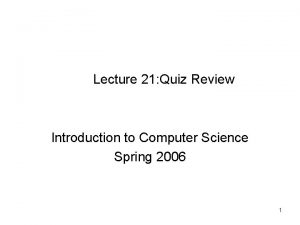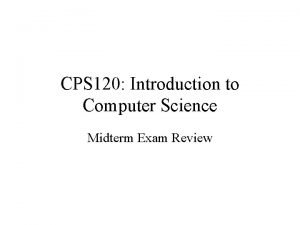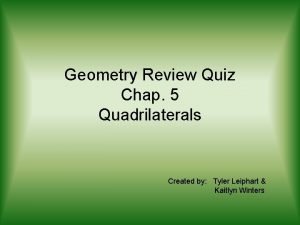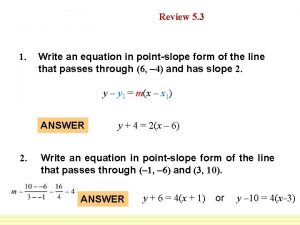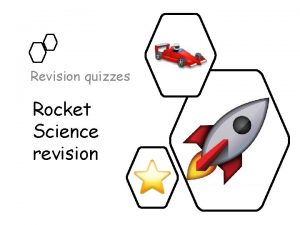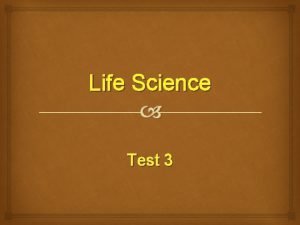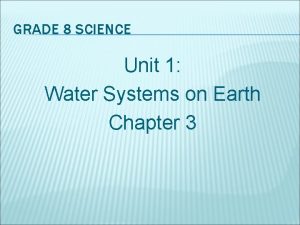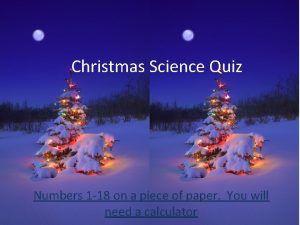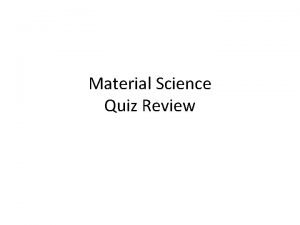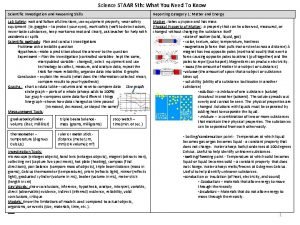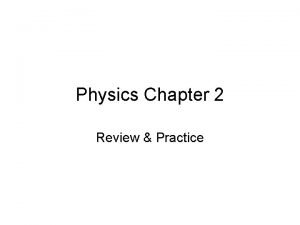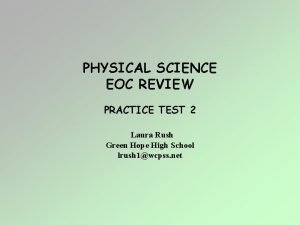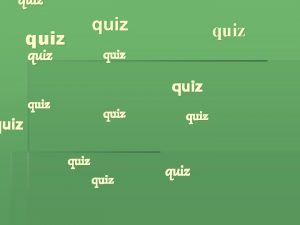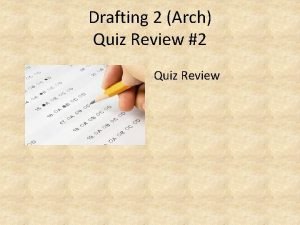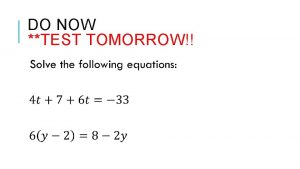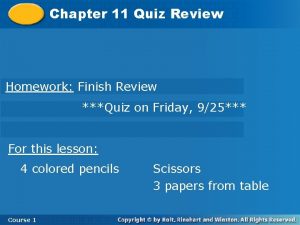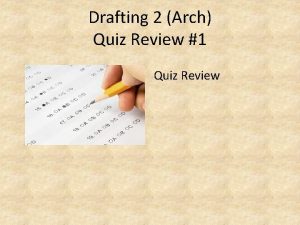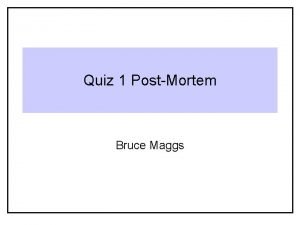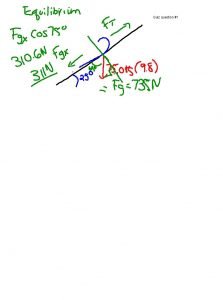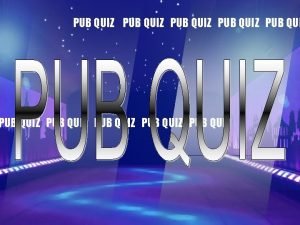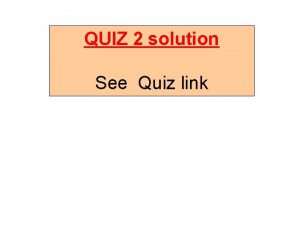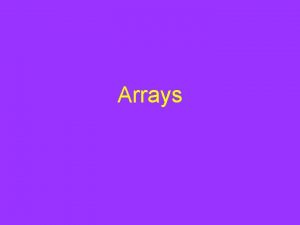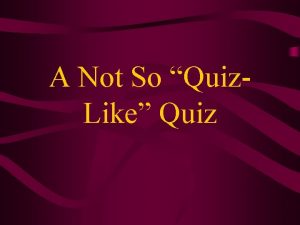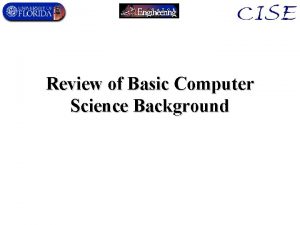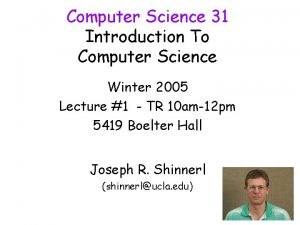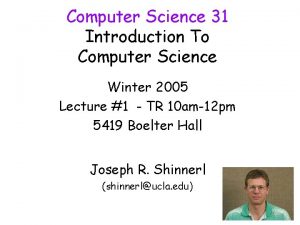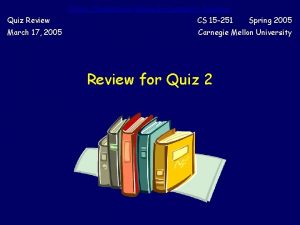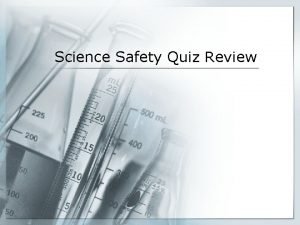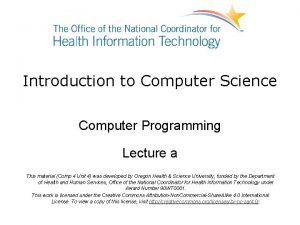Lecture 21 Quiz Review Introduction to Computer Science
































- Slides: 32

Lecture 21: Quiz Review Introduction to Computer Science Spring 2006 1

1. What value is returned by the return statement above? a 0. b 5. c 6. d 7. 2

2. Given the following function prototype: int test(float, char); which of the following statements is valid? a cout<<test(12, &); . b cout<<test(“ 12. 0”, '&'); . c int u = test(5. 0, '*'); . d cout<<test('12', '&'); . 3

3. To use the predefined function tolower, the program must include the header file _____. a cctype. c cmath. b iostream. d cstdlib. 4

4. A function prototype is _____. a a definition, but not a c a declaration, but not. declaration. a definition b a declaration and a. definition d a comment line. 5

5. Given the following function prototype: double try. Me(double, double); which of the following statements is valid? Assume that all variables are properly declared. a cin>>try. Me(x, y); . b cout<<try. Me(2. 0, 3. 0); . c cout<<try. Me(double, double); . d cout<<try. Me(float, float); . 6

6. Given the following function prototype: int my. Func(int, int); which of the following statements is valid? Assume that all variables are properly declared. a cin>>my. Func(x, y); . b cout<<my. Func(7, 8), 15); . c cin>>my. Func(‘ 2’, ‘ 3’); . d cout<<my. Func(7), 15); . 7

7. Given the above function, choose the output of the following statement: cout<<mystery(9, 7); . a 2. c 7. b 4. d 9. 8

8. Given the above function, choose the output of the following statement: cout<<strange(4, 5); . a -1. c 9. b 1. d 20. 9

9 Assume the above. The output of the statement: cout<<static_cast<int>(tolower('B')); is _____. a 65. c 96. b 67. d 98. 10

10. Given the function prototype: double test. Alpha(int u, char v, double t); which of the following statements is legal? a cout<<test. Alpha(5, 'A', 2); . b cout<<test. Alpha( int 5, char 'A', int 2); . c cout<<test. Alpha(‘ 5. 0’, 'A', 2. 0); . d cout<<test. Alpha(5. 0, 65, 2. 0); . 11

11. Which of the following function prototypes is valid? a int func. Test(int x, int y, float z){}. b func. Test(int x, int y, float){}; . c int func. Test(int, int y, float z). d int func. Test(int, float); . 12

12. Given the function prototype: float test(); , which of the following statements is legal? a cout<<test; . c cout<<test(); . b cout<<test(void); . d cout<<test(“Out”). ; 13

13. The output of the statement: cout<<pow(2, pow(3, 1)); is _____. a 6. c 8. b 7. d 9. 14

14. The standard header file for the abs(x)function is _____. a <cmath>. c <cctype>. b <ioinput>. d <cstdlib>. 15

15. Functions that do not have a data type are called _____ functions. a zero. c void. b null. d empty. 16

16. Which statement about prototypes and headers is true? a Parameter names must be listed in the prototype, . but not necessarily in the header. b Prototypes end with a semicolon, but headers do. not. c Headers should come before prototypes. . d Headers end with a semicolon, but prototypes do. not. 17

17. A variable listed in a function call is known as a(n) _____ parameter. A variable list in a header is known as a(n) _____ parameter. a actual; actual. c actual; formal. b formal; formal. d formal; actual. 18

18. If an & is attached after the data type of a formal parameter, then the formal parameter is a _____. a value parameter. c global variable. b reference parameter. d default variable. 19

19. What are the values of x and y after the statements above execute? (Assume that variables are properly declared. ) a x = 10; y = 10. c x = 15; y = 10. b x = 10; y = 15. d x = 15; y = 15. 20

20. What are the values of one and letter after the statements above execute? a one = 5; letter = 'A'. b one = 10; letter = 'A'. c one = 10; letter = 'B'. d one = 12; letter = 'B'. 21

21. parameters are useful when you want to return more than one value from a function. a Default. c Reference. b Value. d Automatic. 22

22. Suppose that print. Heading is a function without any parameters. Which of the following is a valid function heading? a void. b void. c void. d void. print. Heading() print. Heading(no. Parameters) print. Heading(); print. Heading(void); 23

23. A void function accomplish has three parameters: a parameter u of the type int, a parameter v of the type double, and a parameter letter of the type char. The parameters u and letter need to pass their values out of the function and the parameter v is to only receive the value from the calling environment. Which of the following is a correct function heading? a void accomplish(int& u, double v, char& letter) b. void accomplish(int u, double& v, char letter) c. void accomplish(int& u, double v, char& letter); d. void accomplish(int u, double& v, char letter); 24

24. Suppose that you are given the function definition above. What is the output of the following statements? print. Some. Thing(1); print. Some. Thing(2); print. Some. Thing(3); a ******. b *. * * * c. d. * * * * 25

25. What is the output of the program shown above? a 1 1. 3 1 c 1 2. 2 3 b 1 2. 1 3 d 2 2. 2 3 26

26. Which of the following is a legal C++ function definition? a void func. Test(int& u, double& v) { cout<<u<<" "<<v<<endl; } b void func. Test(int& u, double& v); . { cout<<u<<" "<<v<<endl; } c void func. Test(int& u, double& v). ( cout<<u<<" "<<v<<endl ) d void func. Test(int& u, double& v). [ cout<<u<<" "<<v<<endl; ] 27

27. What is the output of the C++ code above? a 4 5. c 6 5. b 6 4. d 6 6. 28

28. Based on the function definition above, which of the following statements is valid? a one is a value parameter and two is a reference. parameter. b one is a reference parameter and two is a value. parameter. c one and two are reference parameters. . d one and two are value parameters. . 29

29. Which of the following is a legal C++ function definition? a void func. Alpha(int u, double v &) { cout<<u<<" "<<v<<endl; } b void func. Alpha(int #, double #). { cout<<u<<" "<<v<<endl; } c void func. Alpha(int &, double &). { cout<<u<<" "<<v<<endl; } d void func. Alpha(int u, double& v). { cout<<u<<" "<<v<<endl; } 30

30. In C++, the scope resolution operator is _____. a |. b. . c : . d : : . 31

#include <iostream> void Calc. Rectangle(double length, double width, double& circum, double& area); void Print. Result(double length, double width, double circum, double area); using namespace std; int main() { double length, width, circumference, area; cout<< “This program will calculate the circumference and area of the rectangle. ” cout << “Please input the length and width of the rectangle: ” << endl; cin>>length >> width; Calc. Rectangle(length, width, circum, area); Print. Result(length, width, circum, area); return 0; } void Calc. Rectangle(double length, double width, double& circum, double& area); { circum = 2*(length+width); area = length * width; } void Print. Result(double length, double width, double circum, double area); { cout << “Length = ” << length <<endl; cout << “ Width = ”<< width <<endl; cout << “ Circumference = ” << circum <<endl; cout << “ Area = ”<< area <<endl; } 32
 Introduction to computer science quiz
Introduction to computer science quiz 01:640:244 lecture notes - lecture 15: plat, idah, farad
01:640:244 lecture notes - lecture 15: plat, idah, farad What's your favourite lesson
What's your favourite lesson K5 think central
K5 think central Introduction to computer science midterm exam
Introduction to computer science midterm exam Introduction to computer science midterm exam test
Introduction to computer science midterm exam test Python programming an introduction to computer science
Python programming an introduction to computer science Physical science lecture notes
Physical science lecture notes Computer security 161 cryptocurrency lecture
Computer security 161 cryptocurrency lecture Computer-aided drug design lecture notes
Computer-aided drug design lecture notes Computer architecture lecture notes
Computer architecture lecture notes Microarchitecture vs isa
Microarchitecture vs isa Introduction to biochemistry lecture notes
Introduction to biochemistry lecture notes Introduction to psychology lecture
Introduction to psychology lecture Introduction to algorithms lecture notes
Introduction to algorithms lecture notes Deductive reasoning example
Deductive reasoning example Inductive vs deductive reasoning
Inductive vs deductive reasoning A rhombus is a parallelogram always sometimes never
A rhombus is a parallelogram always sometimes never How to change standard form to slope intercept form
How to change standard form to slope intercept form Chapter review motion part a vocabulary review answer key
Chapter review motion part a vocabulary review answer key Writ of certiorari ap gov example
Writ of certiorari ap gov example Narrative review vs systematic review
Narrative review vs systematic review Prisma diagram example
Prisma diagram example Narrative review vs systematic review
Narrative review vs systematic review Rocket science questions and answers
Rocket science questions and answers Quiz 3 life science
Quiz 3 life science Mr collinson grade 8 water systems
Mr collinson grade 8 water systems What metallic element is mentioned in the bleak midwinter
What metallic element is mentioned in the bleak midwinter Materials science quiz
Materials science quiz Reporting category 3 earth and space
Reporting category 3 earth and space Nys earth science lab practical
Nys earth science lab practical Glencoe physical science chapter 2 review answers
Glencoe physical science chapter 2 review answers Science eoc review
Science eoc review
